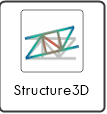APPLICATION STRUCTURE 3D
Women Graduates are trained with basics in Industry application from basic science Mathematics, Physics, Chemistry
Training in application Software by Industry Professional, to train others with preparation as TRAINER to empower.
Empowering areas are ACADEMIC SERVICE-ENTREPRENEURSHIP-DESIGN SERVICE-INDUSTRIES-SOCIAL ENGINEERING
AIM of this training is to get employment directly or indirectly from Industries, Government organization either state or central bodies. Also to develop or support rural industries & other application industries either as induvial or self group
APM Structure3D computational kernel for finite element analysis
APM Structure3D computational kernel for finite element analysis
STRUCTURE 3D
APM Structure 3D
Finite element types
When creating a building object model, you can use the following types of finite elements:
- rod - arbitrary cross sections;
- flexible elements - ropes;
- lamellar - triangular and quadrangular;
- shell;
- solid state - isoparametric four-node, six-node and eight-node;
- special elements: elastic links, elastic supports, contact elements, concentrated masses and moments of inertia.
APM Structure 3D
Finite element types
When creating a building object model, you can use the following types of finite elements:
- rod - arbitrary cross sections;
- flexible elements - ropes;
- lamellar - triangular and quadrangular;
- shell;
- solid state - isoparametric four-node, six-node and eight-node;
- special elements: elastic links, elastic supports, contact elements, concentrated masses and moments of inertia.
Loads and impacts
- concentrated forces and moments (constant and variable in time);
- distributed loads along the length, area and volume (constant and variable in time);
- loads given by linear and / or angular displacement (constant and variable in time);
- snow, wind and seismic (according to SNiP), taking into account distributed and concentrated masses, linear and rotational degrees of freedom;
- hydrostatic type pressure;
- contact type pressure;
- design combinations of efforts (DCF);
- centrifugal (specified by linear and/or angular acceleration);
- gravity;
- temperature gradients;
- to simulate the real loading of the structure model, it is possible to use arbitrary combinations of the loads listed above.
Loads and impacts
- concentrated forces and moments (constant and variable in time);
- distributed loads along the length, area and volume (constant and variable in time);
- loads given by linear and / or angular displacement (constant and variable in time);
- snow, wind and seismic (according to SNiP), taking into account distributed and concentrated masses, linear and rotational degrees of freedom;
- hydrostatic type pressure;
- contact type pressure;
- design combinations of efforts (DCF);
- centrifugal (specified by linear and/or angular acceleration);
- gravity;
- temperature gradients;
- to simulate the real loading of the structure model, it is possible to use arbitrary combinations of the loads listed above.

